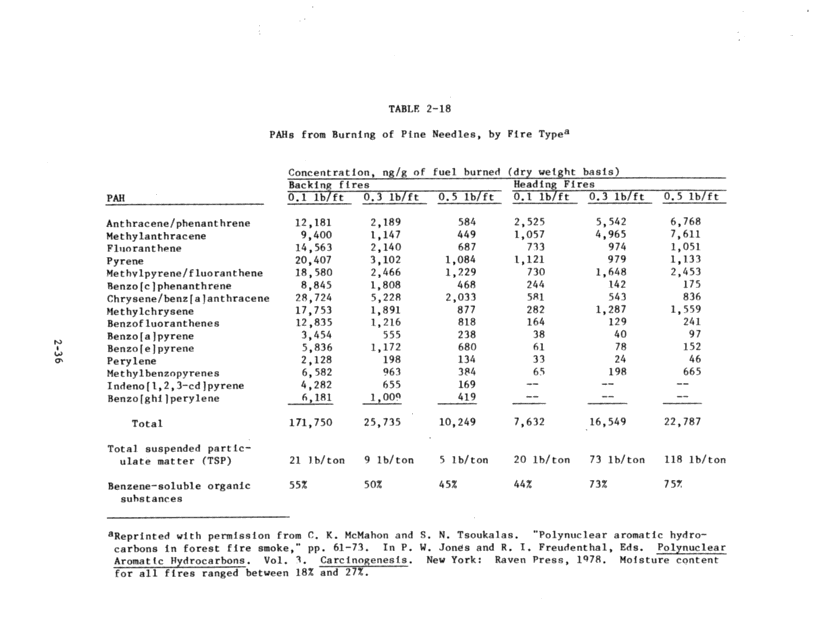Smoke from Forest Fires
Most people who die in building fires do not die of smoke per se, but rather of inhalation of very hot gases. Here is a description of "smoke inhalation" from the perspective of emergency medical treatment (read the first third). While such conditionings might be present in the midst of a forest fire, the gases would cool considerably before they reach "town."
In Fairbanks last summer, we were exposed to a heavy concentration of smoke, but not heat, from the fires. In general, the high temperatures of the fire cause soot and combustion gases to rise. The soot either does not rise very high in the first place, or it settles. while gases tend to mix by convection and diffusion, such that high concentrations of gases are also not common.
Smoke is made up primarily of carbon dioxide, water vapor, carbon monoxide, particulate matter, hydrocarbons and other organics, nitrogen oxides, and trace minerals. What is in smoke varies by the fuel source. Different types of wood and vegetation are made up of varying amounts of cellulose, lignin, tannins and other polyphenolics, oils, fats, resins, waxes and starches. Depending on the amounts of each substance burned, different compounds are produced.
Today, the major pollutant of concern from wildfire smoke is particulate matter or PM. PM is a mixture of solid particles and liquid droplets found in air. Particulate matter found in smoke tends to be very small (less than one micron in diameter), and is more of a health concern than coarser particles usually found in road dust. The size range of particulate matter from smoke is close to the wavelength of visible light (0.40.7 micrometers). This makes smoke particles good at scattering light and reducing visibility.
[ http://depts.washington.edu/pmcenter/news_sum01.html]
Health Effects of Smoke. Here's a pretty good summary, but a little overdone in places:
Smoke causes eye and respiratory tract irritation along with asthma, bronchitis, and reduced lung function, and can contribute to premature death. Studies have found that fine particulate matter is linked (alone or with other pollutants) with a number of significant respiratory and cardiovascular-related effects, including increased mortality and aggravation of existing respiratory and cardiovascular disease.
Airborne particles are respiratory irritants, and laboratory studies show that high concentrations of particulate matter (PM) cause persistent cough, phlegm, wheezing, and physical discomfort in breathing. PM can alter the body's immune system and affect removal of foreign materials from lungs, such as pollen or bacteria.
Carbon monoxide (CO) enters the bloodstream through the lungs and reduces oxygen delivery to the body's organs and tissues. Even low levels of CO are serious for those with cardio-vascular disease. At higher levels, carbon monoxide exposure can cause headaches, dizziness, visual impairment, reduced work capacity, and reduced manual dexterity even in otherwise healthy individuals. At even higher levels (seldom associated solely with a forest fire), carbon monoxide can be deadly.
People exposed to toxic air pollutants at sufficient concentrations and durations potentially have an increased risk of cancer or other serious health problems. However, in general, the long-term risk of toxic air pollutants from most vegetative fires such as forest fires is believed to be low due to the short exposure duration. More research is needed in this area to measure exposures to toxic air pollutants from wild fires and other vegetative burning exposures.
Some components of smoke, such as many polycyclic aromatic hydrocarbons (PAH's), are carcinogenic. One of the most carcinogenic is benzo-a-pyrene (BaP). Other components, such as the aldehydes, are acute irritants.
Examples of three air toxics of concern from wildfires are:
What else is in forest fire smoke?
 From Polycyclic Aromatic Hydrocarbons: Evaluation of Sources and Effects (1983)
From Polycyclic Aromatic Hydrocarbons: Evaluation of Sources and Effects (1983) These three sources have good information about health effects versus particulates and composition of particulates.
“Health effects associated with Forest Fires among residents of the Hoopa Valley National Indian Reservation” [http://depts.washington.edu/wildfire/resources/Epi2Hoopa.doc]
Here's a paper with some detailed sampling of the particles in forest fire smoke and what's in them:
Air Sampling Study of the 2000 Montana Wildfire Season
[http://depts.washington.edu/wildfire/resources/AWMAPaper2.doc]
Here's the paper that generated the table below:
Polytnuclear Aromatic Hydrocarbons in Forest Fire Smoke
http://www.srs.fs.usda.gov/pubs/ja/ja_mcmahon016.pdf
So the toxicity of smoke is due to the nature of the particulates. Let's talk about them.
If there are hydrophilic contaminants in particles and we inhale the particulates, what happens? And there is the difference between PM 2.5 and PM 10, at least statistically. Most PM 10 will fall in the URT, upper respiratory tract, while some of the PM 2.5 will be deposited in the lungs. The particles will be cleared from the URT by mucus, which is essentially watery, so the partitioning from the particle to the mucus would be slow and, on the average, most of the PAH from the PM 10 would wind up in the GI tract. If the PAH's on the PM 2.5 wind up in the alveoli, one would expect more rapid partitioning of the PAH's to the endothelium and pulmonary tissues, and at a slower rate, from the particles to the alveolar macrophages. I don't know of any harm from the particles engulfed by the macrophages. So, Benzo(a)pyrene from the forest fire soot would expose the GI tract and the lungs. We might compare the GI tract exposure with that of eating barbequed steak, or the lung exposure to cigarette smoking. And there I stop.